This article is contributed by the ChaMd5 Security Team IOT Group.


This is a summary of the theoretical knowledge learned recently about side-channel attacks and fault injection. If there are any mistakes or areas for improvement, I hope experts will correct me.
First, let’s introduce several common encryption algorithms.
Encryption Algorithms
RSA Encryption Algorithm
RSA is an asymmetric encryption algorithm.
Generation of Public and Private Keys
Randomly select two distinct large prime numbers p and q, and calculate N=p * q.
Using Euler’s function, obtain φ(N)=φ(p) * φ(q)=(p−1) * (q−1).
Select an integer e less than φ(N) such that e and φ(N) are coprime. Then find the modular inverse of e with respect to φ(N), named d, such that:
φ(N) mod (e * d) = 1 (which indicates φ(N) % (e * d) == 1).
Destroy the records of p and q.
At this point, (N,e) is the public key and (N,d) is the private key.
Message Encryption
First, the message needs to be transformed into an integer m that is less than N and coprime to N, in a format agreed upon by both parties. If the message is too long, it can be split into several parts, which is known as block encryption. Each part is then encrypted using the following formula:
c ≡ m^e mod N (where ^ denotes exponentiation; plaintext m is transformed into ciphertext c after encryption).
Message Decryption
Utilize the key d for decryption.
m ≡ c^d mod N.
If the key d is obtained, the ciphertext can be decrypted.
AES Encryption Algorithm
AES is a block cipher that encrypts data through iterative encryption operations.
AES128, AES192, and AES256 represent encryption with key lengths of 128, 192, and 256 bits, respectively, with iteration rounds of 10, 12, and 14.
AES divides each plaintext block into 128 bits, which is 16 bytes. If it does not meet the 16-byte requirement, padding is necessary.
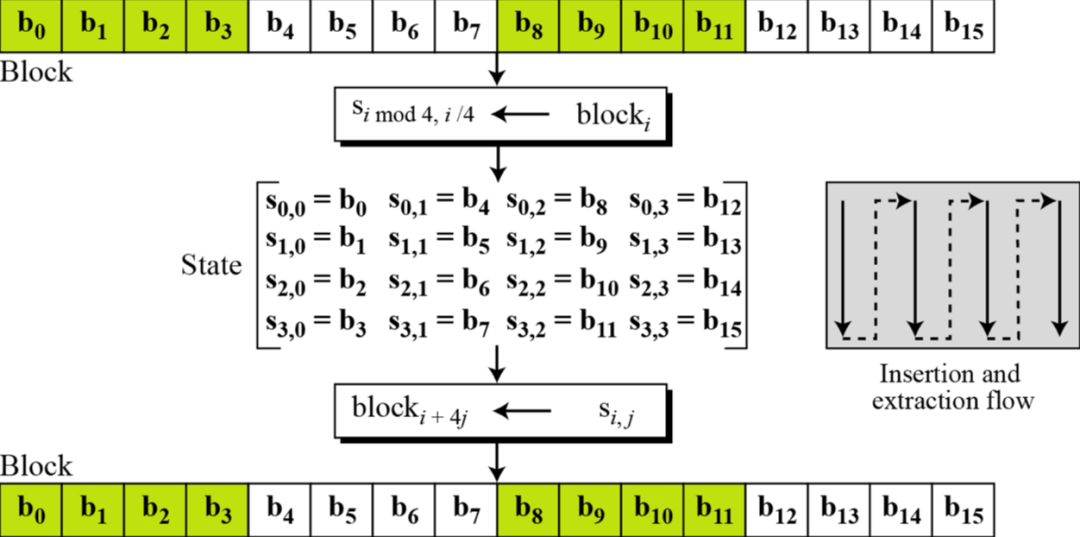
(As shown, the order can be expressed in matrix form.)
Padding strategies:
-
NoPadding (requires plaintext to be a multiple of 16 bytes).
-
PKCS5Padding (default).
If the plaintext block is less than 16 bytes, the necessary number of characters is appended at the end, and the value of each byte equals the number of missing characters.
For example, plaintext:
{1,2,3,4,5,a,b,c,d,e}missing 6 bytes would be completed as{1,2,3,4,5,a,b,c,d,e,6,6,6,6,6,6}. -
ISO10126Padding.
If the plaintext block is less than 16 bytes, the necessary number of bytes is appended at the end, with the last character’s value equal to the number of missing bytes, and other characters filled with random numbers.
For example, plaintext:
{1,2,3,4,5,a,b,c,d,e}missing 6 bytes could be completed as{1,2,3,4,5,a,b,c,d,e,5,c,3,G,$,6}.
The general process for AES128 encryption:
-
Initial Round (1 time). -
Normal Rounds (N times). -
Final Round (1 time).
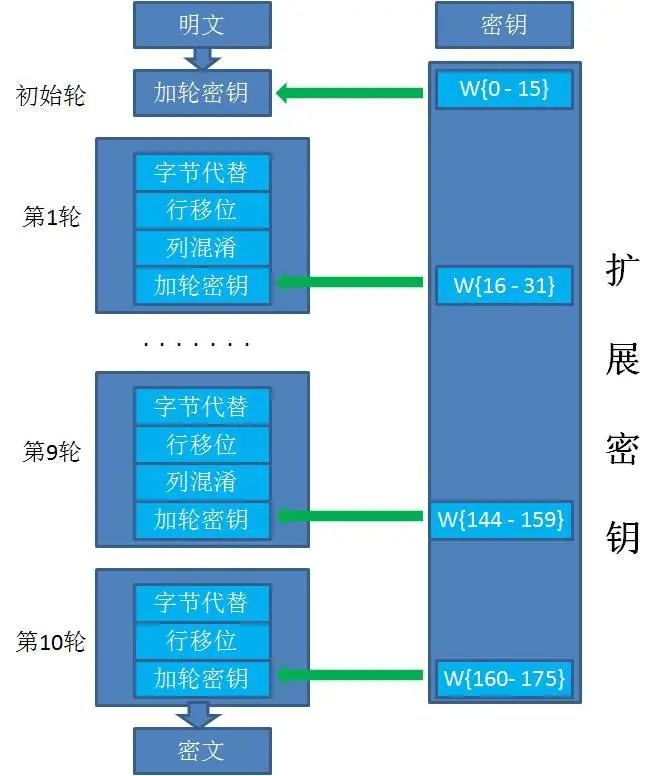
Initially, the key is 128 bits, or 16 bytes, and through key expansion, it is extended to 176 bytes.
Following the sequence of normal rounds:
-
Byte Substitution.
Each byte of the plaintext block is replaced with another byte according to the S-box.
S-box:
0 1 2 3 4 5 6 7 8 9 a b c d e f 0 0x63 0x7c 0x77 0x7b 0xf2 0x6b 0x6f 0xc5 0x30 0x01 0x67 0x2b 0xfe 0xd7 0xab 0x76 1 0xca 0x82 0xc9 0x7d 0xfa 0x59 0x47 0xf0 0xad 0xd4 0xa2 0xaf 0x9c 0xa4 0x72 0xc0 2 0xb7 0xfd 0x93 0x26 0x36 0x3f 0xf7 0xcc 0x34 0xa5 0xe5 0xf1 0x71 0xd8 0x31 0x15 3 0x04 0xc7 0x23 0xc3 0x18 0x96 0x05 0x9a 0x07 0x12 0x80 0xe2 0xeb 0x27 0xb2 0x75 4 0x09 0x83 0x2c 0x1a 0x1b 0x6e 0x5a 0xa0 0x52 0x3b 0xd6 0xb3 0x29 0xe3 0x2f 0x84 5 0x53 0xd1 0x00 0xed 0x20 0xfc 0xb1 0x5b 0x6a 0xcb 0xbe 0x39 0x4a 0x4c 0x58 0xcf 6 0xd0 0xef 0xaa 0xfb 0x43 0x4d 0x33 0x85 0x45 0xf9 0x02 0x7f 0x50 0x3c 0x9f 0xa8 7 0x51 0xa3 0x40 0x8f 0x92 0x9d 0x38 0xf5 0xbc 0xb6 0xda 0x21 0x10 0xff 0xf3 0xd2 8 0xcd 0x0c 0x13 0xec 0x5f 0x97 0x44 0x17 0xc4 0xa7 0x7e 0x3d 0x64 0x5d 0x19 0x73 9 0x60 0x81 0x4f 0xdc 0x22 0x2a 0x90 0x88 0x46 0xee 0xb8 0x14 0xde 0x5e 0x0b 0xdb a 0xe0 0x32 0x3a 0x0a 0x49 0x06 0x24 0x5c 0xc2 0xd3 0xac 0x62 0x91 0x95 0xe4 0x79 b 0xe7 0xc8 0x37 0x6d 0x8d 0xd5 0x4e 0xa9 0x6c 0x56 0xf4 0xea 0x65 0x7a 0xae 0x08 c 0xba 0x78 0x25 0x2e 0x1c 0xa6 0xb4 0xc6 0xe8 0xdd 0x74 0x1f 0x4b 0xbd 0x8b 0x8a d 0x70 0x3e 0xb5 0x66 0x48 0x03 0xf6 0x0e 0x61 0x35 0x57 0xb9 0x86 0xc1 0x1d 0x9e e 0xe1 0xf8 0x98 0x11 0x69 0xd9 0x8e 0x94 0x9b 0x1e 0x87 0xe9 0xce 0x55 0x28 0xdf f 0x8c 0xa1 0x89 0x0d 0xbf 0xe6 0x42 0x68 0x41 0x99 0x2d 0x0f 0xb0 0x54 0xbb 0x16 For example, byte
a[0,0]='a'which is0x61, is replaced withb[0x6,0x1]=0xefaccording to the S-box, thus after replacementa[0,0]=0xef. -
Row Shift.
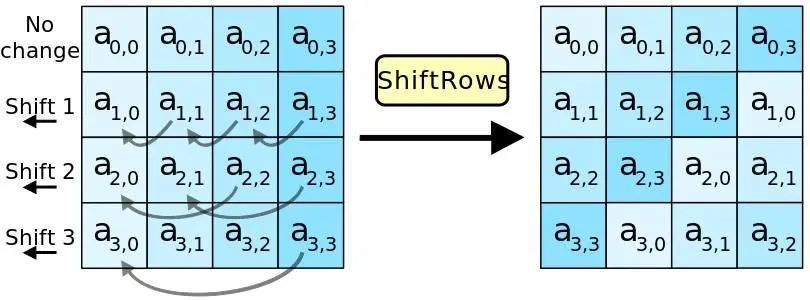
The first row remains unchanged.
The second row is cyclically shifted left by 1 byte.
The third row is cyclically shifted left by 2 bytes.
The fourth row is cyclically shifted left by 3 bytes.
-
Column Mixing.
After the row shift, each column of the matrix is multiplied by a fixed constant matrix to get the corresponding output column.
-
Add Round Key.
Each byte of the input array is XORed with the corresponding byte of the key array.
Key expansion is also performed (the expansion algorithm is reversible, meaning that the first 16 bytes of the key can be derived from the last 16 bytes).
In summary, the entire AES128 encryption process involves XORing the plaintext with the key in the first round, followed by four transformations for nine normal rounds, and then performing three transformations in the final round, excluding column mixing, to complete the encryption.
If any round key is obtained, combined with the S-inverse box and other known information, all keys can be derived to decrypt the ciphertext.
Basics of Oscilloscopes
Digital Oscilloscope
Collects voltage signals.
-
Sampling: Set the sampling rate (the number of signals collected per second), generally 5-10 times the chip signal frequency.
-
Quantization: Set the vertical resolution and vertical range.
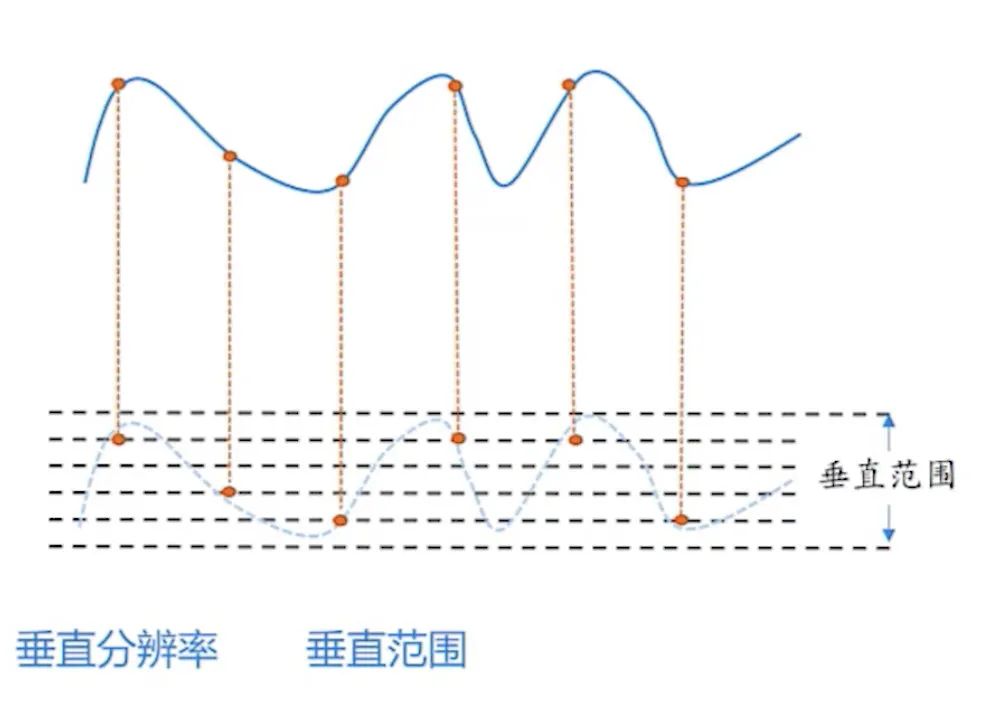
-
Trigger: The starting signal for recording by the oscilloscope.
Setting Up a Collection Environment
Passive high-impedance probes require one end to be grounded.
Active differential probes have no such requirement.
-
Add a resistor and use an active differential probe to collect the voltage across the resistor to calculate the current flowing through the circuit board and measure the power of the circuit board.
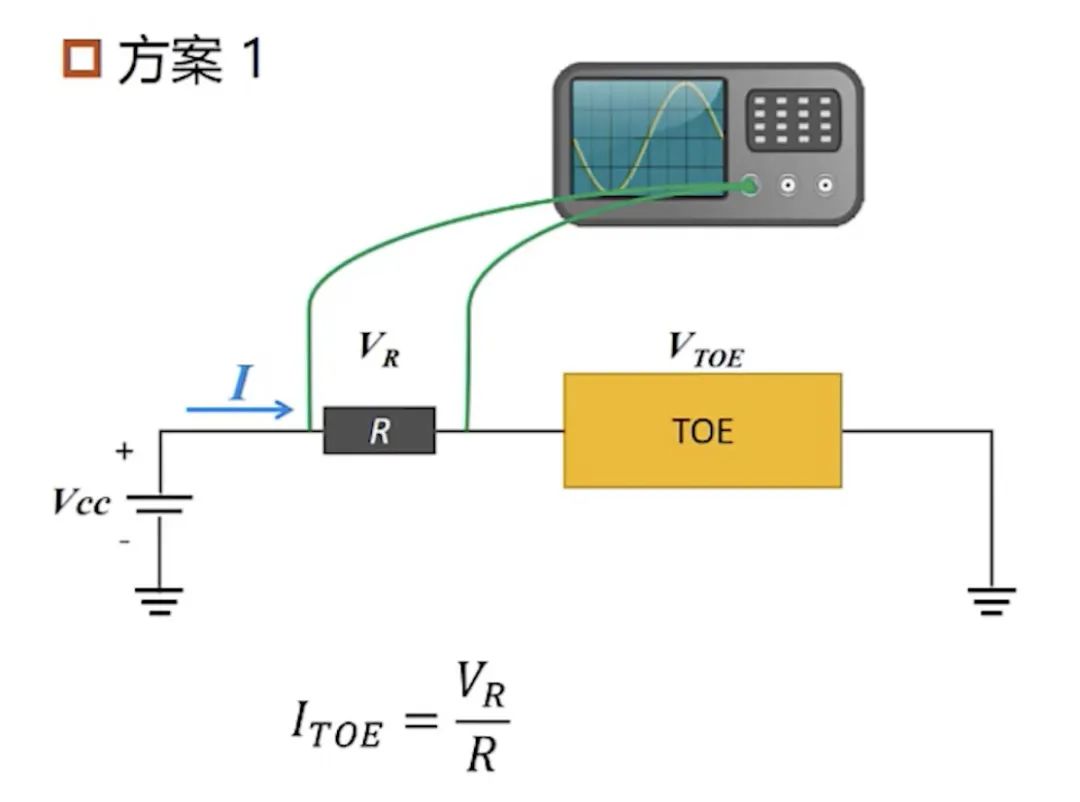
-
Add a resistor at the ground end, use a passive high-impedance probe to collect the voltage across the resistor, and calculate the current flowing through the circuit board to measure the power of the circuit board.
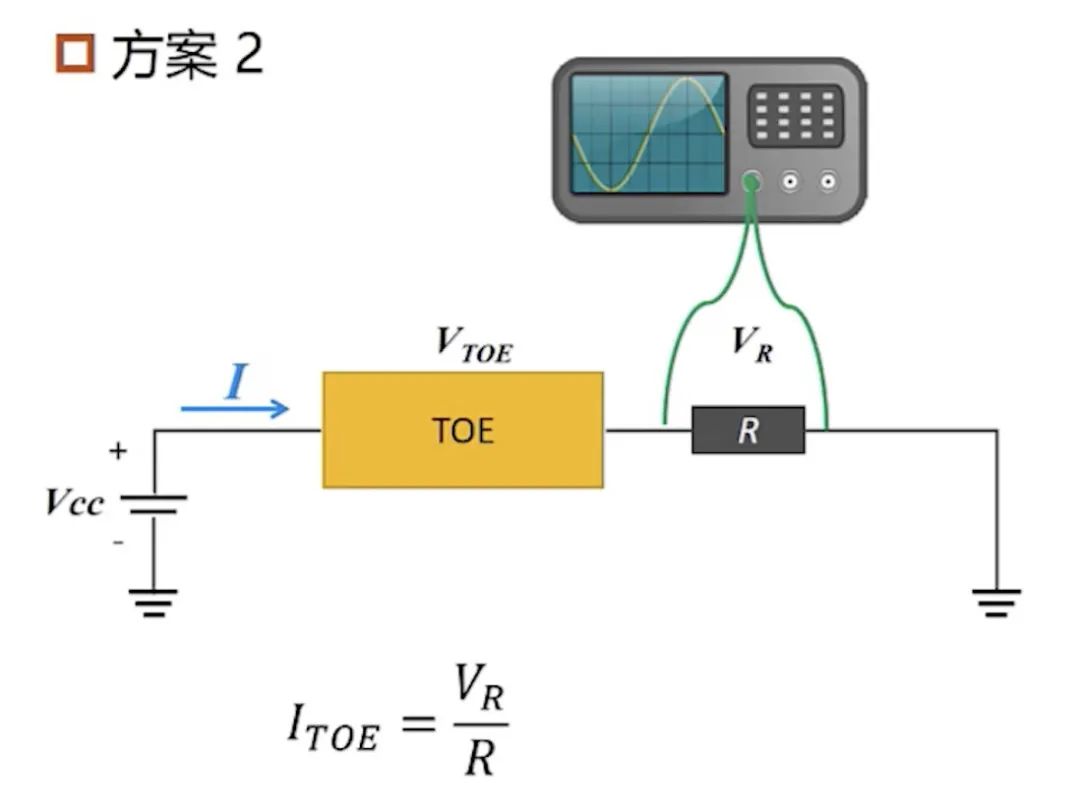
However, this may cause the resistor to be grounded.
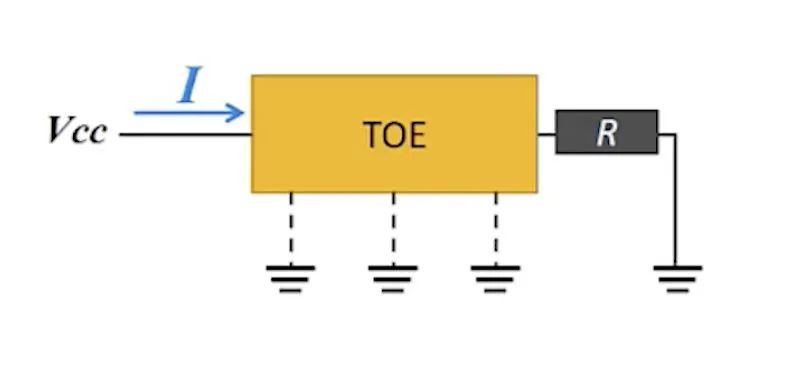
-
Use a current probe to measure the current flowing through the circuit board to measure the power of the circuit board.
-
Use an electromagnetic probe to measure the electromagnetic radiation on the surface of the chip to measure the power of the circuit board.
Side-Channel Attacks
The principle is that the energy consumption of a circuit is related to the data involved in the computation and the operations performed.
Under the influence of predicting keys, we can obtain all intermediate computation results through a circuit model. Based on the dependency of energy consumption on the intermediate results, we can derive predicted energy consumption outputs.
Software Power Consumption Models
-
Hamming Weight Model.
Hamming Weight: The number of non-zero symbols in a string of symbols.
Because the CPU pre-charges all bit values to 1 after processing data in registers and buses, changes from 0 to 1 can result in energy variations that may leak data. Thus, the circuit power consumption is approximately linearly correlated with the Hamming weight of the data written to the register.
T(power) = k(constant) * HW(x)(Hamming Weight) + d(constant)
-
Hamming Distance Model.
Hamming Distance: The number of differing bits between two binary numbers of the same length, which is the number of 1s after XORing the two binary numbers (Hamming Weight).
When a device flips in the circuit at a moment, meaning it changes from high to low or vice versa, dynamic power consumption occurs; otherwise, only static power consumption occurs.
The more bits flipped, the greater the circuit’s power consumption.
The power consumption before and after the device flips is approximately linearly correlated with the Hamming distance between the binary numbers before and after the flip.
T(power) = k(constant) * HD(V0, V1)(Hamming Distance) + d(constant)
Simple Power Analysis — SPA
SPA Attack on RSA Key
RSA can be attacked by SPA based on the fast modular exponentiation algorithm included in RSA.
The fast exponentiation algorithm is as follows:

The C code implementation is:
int PowerMod(int a, int b, int c)
{
int ans = 1;
a = a % c;
while(b>0) {
if(b % 2 == 1) // When b is odd, the following instruction will execute more
ans = (ans * a) % c;
b = b/2;
a = (a * a) % c;
}
return ans;
}During the calculation of fast exponentiation, the value of the exponent is determined bit by bit, leading to different operations.
Thus, during the decryption process, the key d (the value of b in the above figure and code) can be restored from the energy traces, directly yielding the binary value of d in reverse order.
SPA Attack on AES Algorithm Structure
Due to different operations, the energy trace waveforms have distinct characteristics, allowing the analysis of energy traces to determine the algorithm structure used during AES encryption.
Differential Power Analysis — DPA
Encrypt a large number of plaintexts pi with the key to obtain multiple energy traces Ti. Then, for these plaintexts, perform operations with a guessed key k (256 times), resulting in multiple intermediate values x. Using the value of a certain state byte of x as a distinguishing function, divide the data into two groups, calculate the average power consumption of the two groups, and then analyze the differences between the two average power consumptions to derive the key (bit by bit).
Understanding through examples:
Taking AES128 as an example:
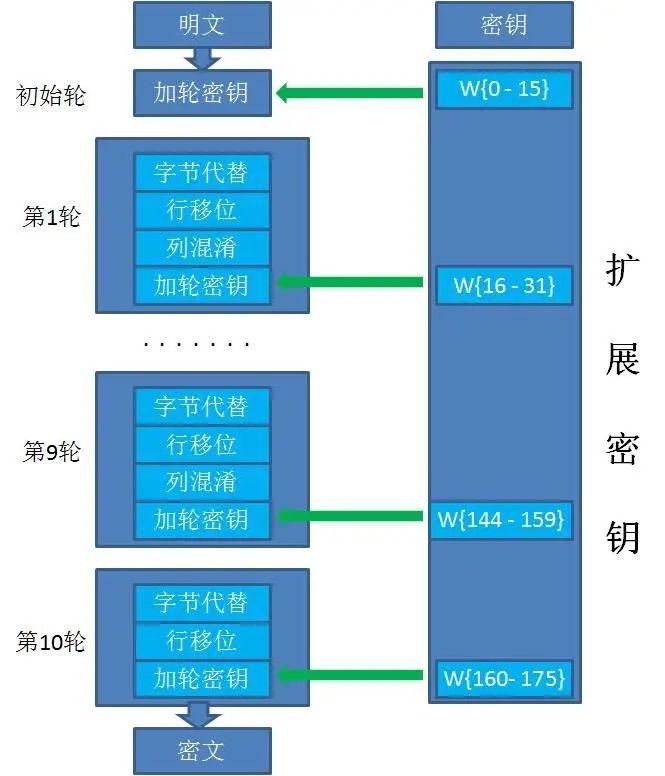
It can be viewed as the encryption method with transformation steps, excluding the last round:
-
Add Round Key. -
Byte Substitution. -
Row Shift. -
Column Mixing.
Attack steps:
-
Perform encryption operations on pi and obtain i energy traces Ti through the oscilloscope.
-
Brute-force the key k byte by byte, requiring 256 attempts for each byte
(0~0xff). For each guessed value of k, perform the following operations to brute-force the key byte by byte. -
Perform i operations to XOR the plaintext pi with the guessed k and obtain the intermediate value xi through S-box substitution (in other words, for each byte of the key k, there are i*256 values of x).
-
Use the value of a certain state byte of the XORed intermediate result xi as a distinguishing function (for example, checking if the last byte is 1) to divide the i energy traces (where the energy traces are obtained by encrypting pi with the correct key) into two groups, calculate the average power consumption of the two groups, and then analyze the difference between the two average power consumptions.
-
Only the correct key can distinguish between the two groups of power consumption data, so the differential power value of the correct key is the largest.
(The graph is approximately as shown.)

The purpose of this is:
Compared to the Hamming weight power consumption model, when calculating xi, the power consumption for each bit in xi differs when it is 1 versus when it is 0.
Assuming that for a certain guessed k, when calculating xi, the power consumption is P+a when a certain bit in xi is 1 and P when it is 0.
Thus, only when the groups of energy traces corresponding to whether the bit in xi is 1, using the guessed key k, match with the groups using the correct key will the differential power value a be significantly visible at a certain point in the differential curve.
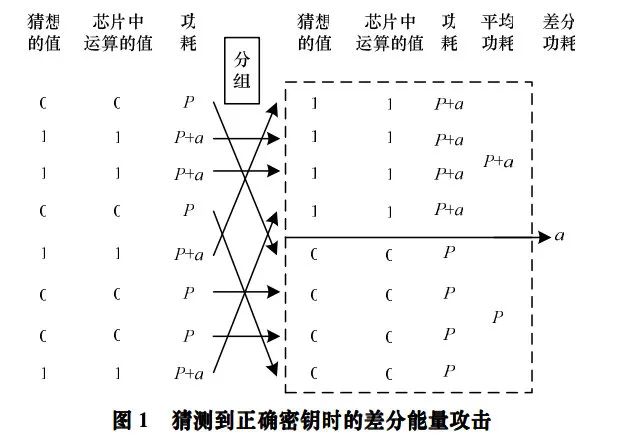
Otherwise, in the case of mutual cancellation, the differential power at that point cannot be distinguished clearly.
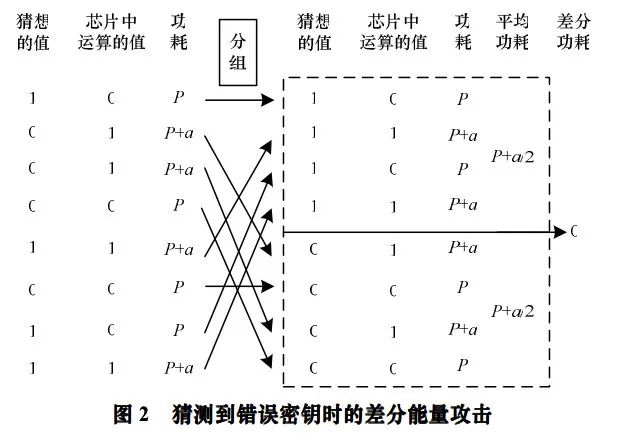
Correlation Power Analysis — CPA
By comparing the Hamming weight of the intermediate values calculated using multiple plaintexts and guessed key values with the energy traces of the normal decryption process, if there are points with a high linear correlation, it indicates that the process of calculating the intermediate values (using this key) exists in the encryption process, thus confirming the key’s correctness (bit by bit).
Understanding through examples:
Taking AES128 as an example:

It can be viewed as the encryption method with transformation steps, excluding the last round:
-
Add Round Key. -
Byte Substitution. -
Row Shift. -
Column Mixing.
The main power consumption occurs during the Byte Substitution stage. For transformations 1 and 2, it can be summarized as XORing the input data with the key byte by byte and then replacing it according to the S-box.
Attack steps:
-
Perform encryption operations on pi and obtain i energy traces Ti through the oscilloscope.
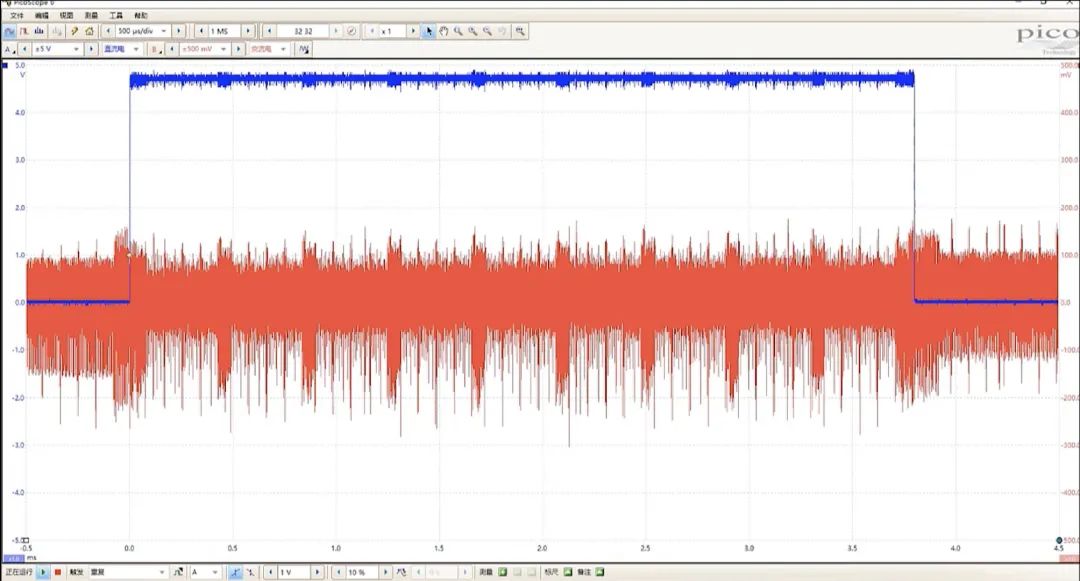
-
Brute-force the key k byte by byte, requiring 256 attempts for each byte
(0~0xff). For each guessed value of k, perform the following operations to brute-force the key byte by byte. -
Perform i operations to XOR the plaintext pi with the guessed k and obtain the intermediate value xi through S-box substitution.
-
Calculate the Hamming weight hw of xi, and perform correlation analysis with each point of the corresponding energy trace Ti, generating a correlation curve.
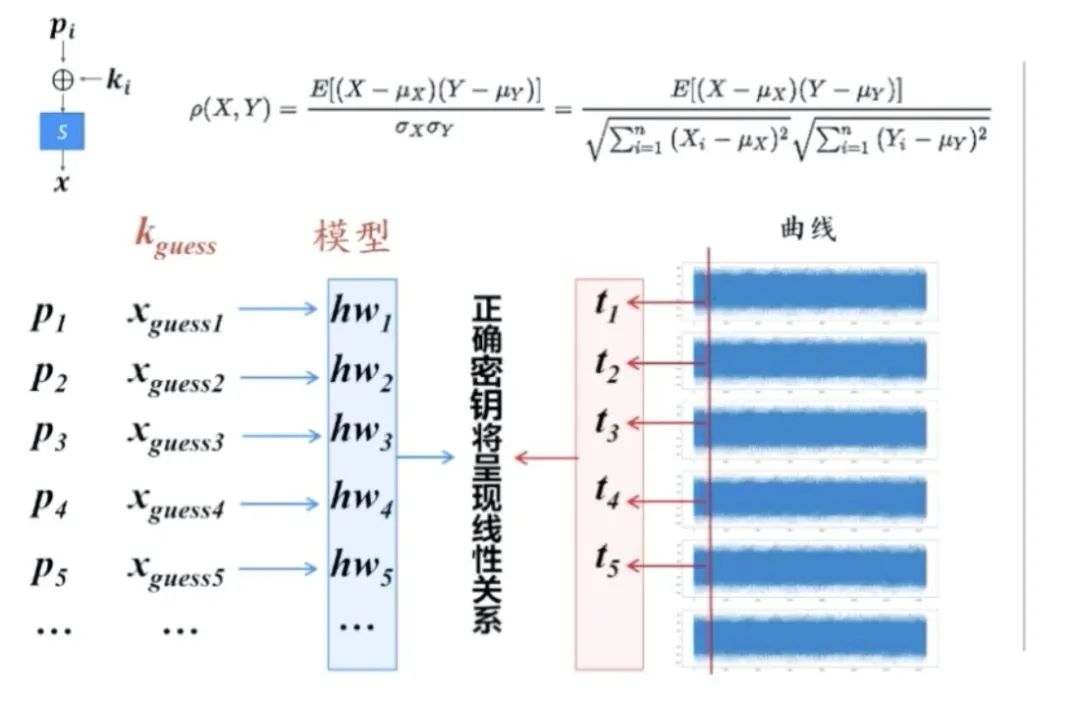
If the Hamming weight of x generated by a guessed k has a high correlation coefficient with a point in the energy trace T (between -1 and 1), it indicates that the computation generating x (using this key) occurred during the encryption process (at a time point with a high correlation coefficient), thus confirming that k is the correct key.

Side-Channel Defense Techniques
-
Time Dimension: Randomized pseudo operations/shuffled operations — randomizing the energy consumption of cryptographic devices. -
Amplitude Dimension: Increasing noise/reducing power consumption — lowering the energy consumption signal-to-noise ratio, making different operands/operations have the same energy consumption. -
Masking Techniques: Altering the intermediate values.
Fault Injection
By external interference, the normal logic of the device is altered, causing the program to produce exploitable errors.
if(pay_pwd_is_correct)
transfer_money();
else
reject_operation();-
Non-invasive attacks: Change external variables such as voltage. -
Semi-invasive attacks: Disassemble the device without direct contact with the chip. -
Invasive attacks: Alter or damage the internal circuitry of the device.
Principles and Types
Critical Path: The normal delay experienced by combinational logic circuits from input to output.
-
Voltage Fault Injection: Lowering the voltage increases the critical path delay, exceeding the clock interval. -
Clock Glitch Injection: The rising edge of the clock arrives early, making the clock interval less than the critical path. -
Electromagnetic Pulse Injection: Electromagnetic effects create localized induced currents (the specific model is still under discussion in academia). -
Laser Injection: The photoelectric effect causes carrier energy level transitions, leading to abnormal conduction of PN junctions. -
Temperature: Generally, an increase in environmental temperature lengthens the critical path.
Objectives
-
Bypass some security mechanisms (file access permissions, secure boot). -
Generate erroneous ciphertext or signatures. -
Combination attacks.
Fault Injection Parameters
-
Attack timing. -
Attack intensity. -
Duration of action. -
Spatial location.
Debugging Parameter Process
-
Record the device state corresponding to different parameters. -
Repeated attempts to narrow the parameter range. -
Adjust strength and duration based on experience. -
Monitor fault injection timing using side-channel analysis.
Error Models
-
Byte errors. -
Word errors. -
Bit errors. -
Random errors. -
Fixed to 0/1.
Attack Steps
-
Identify the attack target.
-
Modify the value of registers.
-
Modify memory (values in DRAM/SRAM).
-
Modify addresses.
-
Modify bus signals.
-
Execute erroneous instructions.
-
Password algorithms.
… …
Carefully read the target device’s data manual and materials.
-
Normal and maximum operating voltage of the chip.
-
Chip clock frequency.
… …
Identify useful signals generated by the target device.
-
Helpful for finding the timing of attacks.
-
Helpful for narrowing the scope of attack events.
-
Helpful for locating the physical position of the attack.
-
High signal-to-noise ratio, easy to implement.
-
Signals from the circuit board can be modified.
-
GPIO control signals.
-
LED indicators on the circuit board.
-
UART, SPI, IIC.
-
Debugging interfaces.
-
Chip reset.
… …
Determine the attack method.
Prepare samples (more than ten).
Criteria for judging attack results.
Begin the attack.
Example
PANDA-CTF 2019 Story
Send “story” to the serial port, and the serial port will output a string of characters where the last part is the flag, triggered by pin8, which is high when outputting to the serial port.
The key process is loading the length of the data to be sent into register R1, setting R2 to 0, and then incrementing R2 for output.
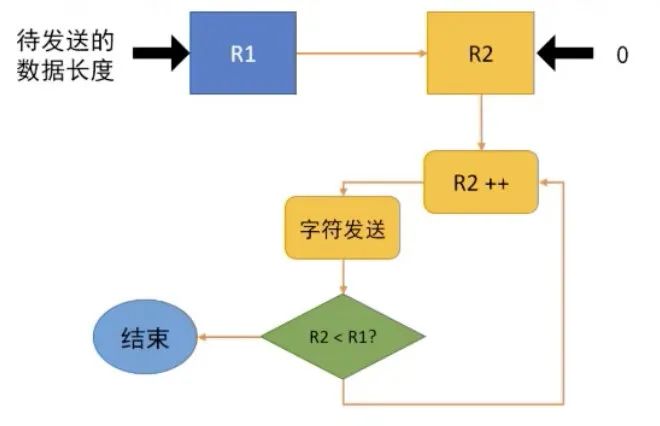
During the operation “loading the length of the data to be sent into register R1”, an attack can be made to increase the number of characters stored in R1, thereby outputting the final flag.
Attack process:
-
Since the output serial port will first pull low as a start bit before outputting the first character, the timing from the trigger rising to the output serial port pulling low can be identified through side-channel analysis, marking it as the timing for our attack, allowing us to attack the operation of loading into R1.
(In the figure, red indicates the trigger pin8, and blue indicates the output serial port.)
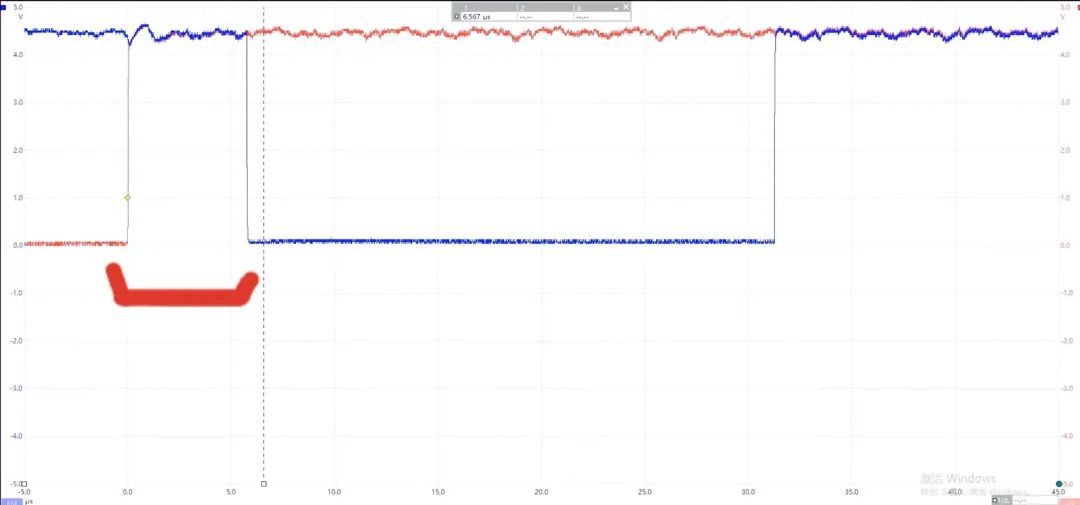
-
Use electromagnetic fault injection devices to attack the chip during that time.
-
Control the device to restart by powering it on and off, repeatedly trying and adjusting attack parameters (trigger time, attack time, intensity, pulse width, location, etc.).
References:
What is the AES Algorithm? (Integrated Edition) https://www.cxyxiaowu.com/3239.html
CTF-wiki https://ctf-wiki.org/crypto/introduction
New Creation Information Security – Bilibili https://space.bilibili.com/556358812
“Power and Data Correlation Models in Power Analysis Attacks” http://www.infocomm-journal.com/txxb/CN/article/downloadArticleFile.do?attachType=PDF&id=165670
“Research on the Sample Size Required for Differential Energy Attacks” http://www.ecice06.com/CN/article/downloadArticleFile.do?attachType=PDF&id=24414
end
Recruitment Advertisement
ChaMd5 Venom is recruiting experts to join.
A newly established group focusing on IOT, industrial control, and sample analysis is recruiting long-term.
Welcome to contact[email protected]
